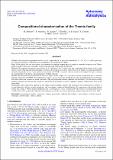Compositional characterisation of the Themis family
Author(s)
Marsset, M.; Vernazza, P.; Birlan, M.; Dumas, C.; Milli, J.; Popescu, M.; DeMeo, Francesca E; Binzel, Richard P; ... Show more Show less
DownloadBinzel_Compositional characterisation.pdf (461.7Kb)
PUBLISHER_POLICY
Publisher Policy
Article is made available in accordance with the publisher's policy and may be subject to US copyright law. Please refer to the publisher's site for terms of use.
Terms of use
Metadata
Show full item recordAbstract
Context. It has recently been proposed that the surface composition of icy main-belt asteroids (B-, C-, Cb-, Cg-, P-, and D-types) may be consistent with that of chondritic porous interplanetary dust particles (CP IDPs).
Aims. In the light of this new association, we re-examine the surface composition of a sample of asteroids belonging to the Themis family in order to place new constraints on the formation and evolution of its parent body.
Methods. We acquired near-infrared spectral data for 15 members of the Themis family and complemented this dataset with existing spectra in the visible and mid-infrared ranges to perform a thorough analysis of the composition of the family. Assuming end-member minerals and particle sizes (<2 μm) similar to those found in CP IDPs, we used a radiative transfer code adapted for light scattering by small particles to model the spectral properties of these asteroids.
Results. Our best-matching models indicate that most objects in our sample (12/15) possess a surface composition that is consistent with the composition of CP IDPs. We find ultra-fine grained (<2 μm) Fe-bearing olivine glasses to be among the dominant constituents. We further detect the presence of minor fractions of Mg-rich crystalline silicates (enstatite and forsterite). The few unsuccessfully matched asteroids may indicate the presence of interlopers in the family or objects sampling a distinct compositional layer of the parent body.
Conclusions. The composition inferred for the Themis family members suggests that the parent body accreted from a mixture of ice and anhydrous silicates (mainly amorphous) and subsequently underwent limited heating. By comparison with existing thermal models that assume a 400-km diameter progenitor, the accretion process of the Themis parent body must have occurred relatively late (>4 Myr after CAIs) so that only moderate internal heating occurred in its interior, preventing aqueous alteration of the outer shell.
Date issued
2016-01Department
Massachusetts Institute of Technology. Department of Earth, Atmospheric, and Planetary SciencesJournal
Astronomy & Astrophysics
Publisher
EDP Sciences
Citation
Marsset, M. et al. “Compositional Characterisation of the Themis Family.” Astronomy & Astrophysics 586 (2016): A15. © 2016 ESO
Version: Final published version
ISSN
0004-6361
1432-0746